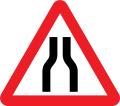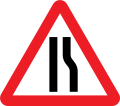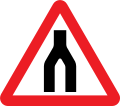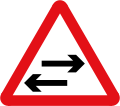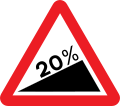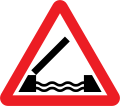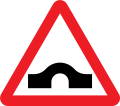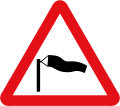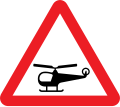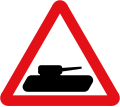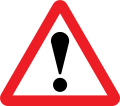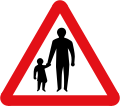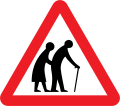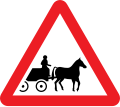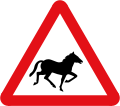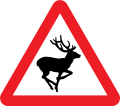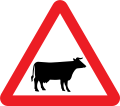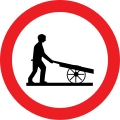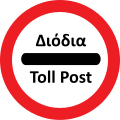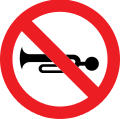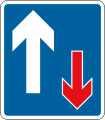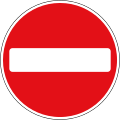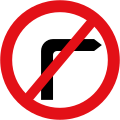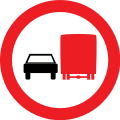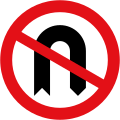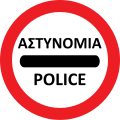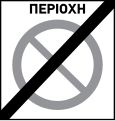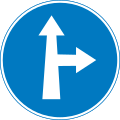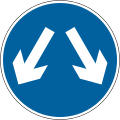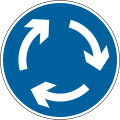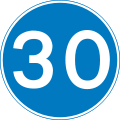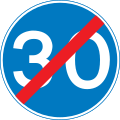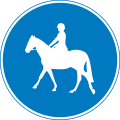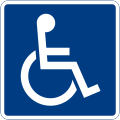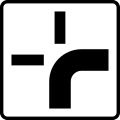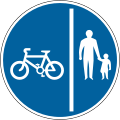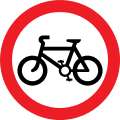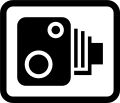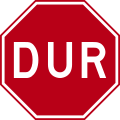Road signs in Cyprus

Road signs in Cyprus are regulated in Law of Street (Greek: Κώδικας Οδικής Κυκλοφορίας, romanized: Kódikas Odikís Kykloforías).[1] They follow the road signs used in most European countries, including European Union countries (France, Germany, Italy etc.), to which Cyprus joined in 2004, as set out in the Vienna Convention on Road Signs and Signals. Cyprus acceded to the Convention on 16 August 2016.[2]
Road signs in Cyprus are similar to road signs used in the United Kingdom since the country was a British colony until 1960 when Cyprus became an independent republic. Some signs are similar to road signs used in Greece. The only exception is that inscriptions on road signs are in Greek and Latin scripts and metric system units are used instead of the Imperial System of units (miles and yards). Distances on road signs are indicated in kilometers. The same applies to Akrotiri and Dhekelia where some road signs are in Turkish as well as English and Greek. Cyprus drives on the left.
Categorisation[edit]
Warning signs[edit]
Warning signs in Cyprus have a triangular shape with a red border and a white background, as in most European countries, while in Greece, warning signs have a yellow background instead of white.
-
Traffic signals ahead
-
Crossroads
-
T-junction
-
Side road
-
Staggered junction
-
Traffic merges from the left
-
Traffic merges onto the main carriageway
-
Roundabout
-
Bend to right (left if symbol reversed)
-
Double bend first to the left (right if symbol reversed)
-
Junction on a bend (symbols may be reversed)
-
Junction on a bend (symbols may be reversed)
-
Road narrows on both sides
-
Road narrows on the right (left if symbols reversed)
-
End of dual carriageway
-
Two-way traffic
-
Two-way traffic on route crossing ahead
-
Steep descent
-
Steep ascent
-
Opening or swing bridge
-
Riverbank or quayside
-
Water course alongside road
-
Soft verges
-
Soft verges
-
Tunnel
-
Hump bridge
-
Uneven road
-
Slippery road
-
Side winds
-
Low-flying aircraft or sudden aircraft noise
-
Low-flying helicopters or sudden helicopter noise
-
Falling or fallen rocks
-
Traffic queues likely ahead
-
Slow-moving military vehicles likely to be in or crossing the road
-
Slow-moving vehicles
-
Ice or Snowdrifts
-
Other dangers (plate must be used to indicate the hazard)
-
Zebra crossing
-
Pedestrians ahead
-
Frail pedestrians likely to cross
-
Children going to or from school
-
Horse-drawn vehicles likely to be in the road
-
Accompanied horses or ponies likely to be in or crossing the road
-
Wild horses or ponies
-
Wild animals
-
Give way ahead (200 m)
-
Stop ahead (50 m)
Additional markings[edit]
-
Distance to level crossing
-
Obstacle
-
Obstacle left
-
Obstacle right
Regulatory signs[edit]
Prohibitory or restriction signs[edit]
-
No hand vehicles
-
No motorcycles
-
No mopeds
-
No motor vehicles
-
No tractors
-
No horse-drawn vehicles
-
Toll post
-
No horn
-
Customs
-
Minimum distance
-
No motor vehicles (both car and motorcycle)
-
Traffic has priority over vehicles from the opposite direction
-
Road closed to all vehicles in both directions
-
No vehicles with a maximum width beyond 2 meters
-
No vehicles with a maximum height exceeding 3.8 meters
-
No goods vehicles exceeding a weight of 7.5 tonnes
-
No goods vehicles
-
No towed caravans
-
No Entry for vehicular traffic
-
No right turn for vehicular traffic
-
No left turn for vehicular traffic
-
Maximum speed limit
-
End of maximum speed limit
-
Priority must be given to vehicles from the opposite direction
-
No overtaking
-
End of no overtaking
-
No overtaking by vehicles
-
Maximum single weight
-
End of all local bans on moving vehicles
-
Maximum length
-
No water heavy vehicles
-
Maximum heavy
-
Vehicles carrying explosives (such as fireworks) prohibited.
-
No U-turns for vehicular traffic
Other regulatory signs[edit]
-
Police
-
Priority road
-
End of priority road
-
Stop, crossroads by children
-
Go ahead or proceed for temporary road works using a hand sign
-
Controlled block stopping is prohibited except when waiting for a right turn
No parking signs[edit]
-
No parking
-
No stopping
-
No parking on odd days
-
No parking on even days
-
No parking zone
-
End of no parking zone
Mandatory signs[edit]
-
Go straight ahead only
-
Turn left
-
Turn right
-
Turn left ahead
-
Turn right ahead
-
Go straight or turn left ahead
-
Go straight or turn right ahead
-
Turn left or right ahead
-
Keep left
-
Keep right
-
Pass on either side
-
One-way lateral road
-
Minimum speed limit
-
End of minimum speed limit
-
Snow chains mandatory
-
Horse street mandatory
-
Pedestrian road mandatory
Signs for traffic reduction measures[edit]
-
Curving road surface, the speed limit is set at 50 km/h
-
Curving road surface, the speed limit is set at 30 km/h
-
Humped crossing
-
Humped pellcan crossing
-
School
-
Road humps left
-
Road humps right
-
Road humps
-
Living street
-
End of living street
Information signs[edit]
-
Confirmation sign
-
Direction sign
-
Direction sign
-
Direction sign
-
Bus stop
-
Pedestrian crossing
-
Parking
-
Dead end straight ahead
-
Dead end left
-
Dead end right
-
Emergency phone
-
Express road
-
End of expressway
-
Open road (Only for vehicles with snow chains)
-
Warning for driving on the left (in Akrotiri and Dhekelia)
-
Vehicle exit
-
General speed limits. Caution. You are driving od the left hand side!
-
Direction sign at a roundabout
-
Confirmation sign
-
Bulit-up area
Additional signs[edit]
-
Allowed only for disabled vehicles
-
Principle of validity of a no stopping and parking sign placed perpendicular to the axis of the street
-
Repetition of the validity of a stop and parking prohibition sign placed perpendicular to the axis of the street
-
End of validity of a stop and parking prohibition sign placed perpendicular to the axis of the street
-
Distance from the sign to the dangerous point or area of prohibition or restriction
-
Length of the hazardous section or area in which a prohibition or restriction applies
-
Principle of validity of a no stopping and parking sign placed parallel to the axis of the street. The validity of the plate extends over [e.g. 10 m] from the position of the sign and in the direction of the arrow
-
Reminder of the validity of a no stopping and parking sign placed parallel to the axis of the street. The validity of the plate extends over (e.g. 5m) on both sides of the sign's location.
-
Icy road
-
Direction of priority road
Other signs[edit]
Street name signs[edit]

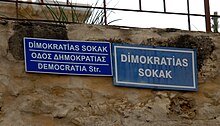
Street name signs are not legally defined as signs in the KOK. This gives authorities flexibility in their design and placement. They can be fixed to a pole, wall or building. The text is in ARIAL font. In the free parts of the island (at least), the signs are identical to those in Greece (white letters on a blue background.), and the text reads: ΟΔΟΣ XXXXX/YYYYYY STR. (Where XXXXX in Greek and YYYYYY in English).
However, in the Turkish-occupied territories, designs vary. The signs placed near the Green Line have three languages, Greek, English and Turkish, and the text is XXXXX SOKAK/STREET YYYYY/ZZZZZZ Str. (Where XXXXX in Turkish, YYYYY in Greek and ZZZZZ in English.). In the rest of the occupied parts it is only in Turkish and is black letters on a yellow background.
Likewise, in Akrotiri and Dekelia, the signs are white with black letters.
Other official signs[edit]
-
Highway
-
Highway exit warning
-
Motorway exit
-
Cycle lane
-
Cycle path separated from pedestrian path.
-
Cycle path separated from pedestrian path. (Alternative)
-
Road shared by cyclists and pedestrians.
-
Road shared by bicycles and buses
-
No bicycles allowed
-
Road with special measures for cyclists.
-
Speed camera
Road signs in Akrotiri and Dhekelia[edit]
Although Akrotiri and Dhekelia is a British Overseas Territory and it has British military bases and installations formerly part of the Crown colony of Cyprus, there is no differentiation in terms of signs and they are defined by the same legislation that is defined in most of the island.[3]
Northern Cyprus[edit]
In the Turkish Republic of Northern Cyprus formed after the Turkish invasion of Cyprus in 1974 and declared its independence from the Republic of Cyprus in 1983, road signs have the same design features as those used in Turkey. Typical differences from signs used in the Republic of Cyprus are:
- DUR instead of STOP on stop sign, although in some cases STOP appears together with DUR or just STOP, despite the rule;
- Red crescent instead of red cross on first aid signs and text in Turkish.
-
Turkish stop sign
-
"Turkish Republic of Northern Cyprus" — TRNC sign, where it is placed at the "border" customs with the free piece
-
"Welcome to the Turkish Republic of Northern Cyprus" — TRNC sign, where it is placed at the "border" customs with the free piece
-
Roundabout sign leading to Nicosia, Larnaca, Athienou and the Turkish-occupied areas.
-
"Stop — Turkish occupied area". Sign of the Republic of Cyprus, where it is placed on the green cease-fire line.
-
Turkish language car ban sign. The Turkish text means "Vehicles may not enter"
-
Turkish direction sign for Leonarisso (Ziyamet)
References[edit]
- ^ "Κώδικας Οδικής Κυκλοφορίας" (PDF). mcw.gov.cy (in Cypriot Greek). Cyprus. 2013.
- ^ "United Nations Treaty Collection". treaties.un.org. Retrieved 28 November 2023.
- ^ "Sovereign Base Areas - Administration". 4 February 2012. Archived from the original on 4 February 2012. Retrieved 22 December 2023.













